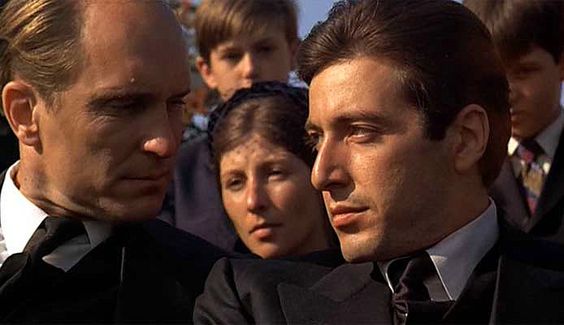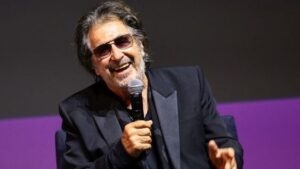
How The Godfather Keeps Giving Us Great Italian American Style

As with any great film, Mr Francis Ford Coppola’s The Godfather tells its story through far more than what the characters say or do. The story of the Corleone family of gangsters, which runs through feuds, violence, love and tragedy, is also conveyed through what they wear. The clothes bring narrative arc, period detail, place and, from Don Vito Corleone’s rose buttonhole to Michael’s pinstripes, power.
The Godfather celebrates its 50th anniversary this year, which gives us a chance to watch it again, but also an opportunity to reassess the clothes and the lasting influence they’ve had on men’s wardrobes.
Tailoring is the focus – the Corleone family don’t do casual – but through this we see the evolution of characters. Michael (Mr Al Pacino), initially a “civilian”, wears the corduroy trousers and sweaters of a preppy post-war, college-educated man for the first half of the film, moving to pinstripes and three-piece suits as he, inevitably, becomes the head of the family. His father, Vito (Mr Marlon Brando), starts with those suits, the famous red rose in his buttonhole, the slightly incongruous cat in his lap. Once retired, he moves to softer shirts and cardigans as the sharp edges of his life fade away.
All this was the work of Ms Anna Hill Johnstone, the veteran costume designer who had worked with Brando on On The Waterfront, as well as with Mr James Dean on East Of Eden in the 1950s. Ms Christina Newland, film critic for the i newspaper, says Hill Johnstone’s experience was critical to The Godfather, which was made in the 1970s, but starts in 1945. “By 1972, she was more than capable of recreating the look, feel and fabrics of that time,” says Newland. “We’re not talking about a contemporary costume designer who is recreating period dress from long before they were born. She was there at the time.”
While Michael’s sojourn in Italy prompts him to adopt the flat caps and open-necked shirts of rural Sicily, it’s the suits (and the Homburg hats) that dominate the film’s fashion legacy. So iconic that they have become the stuff of fancy dress parties, they are also referenced in the wardrobes of the fictional gangsters who have followed (see the made guys of Mr Martin Scorsese’s Goodfellas and Casino and the famous Godfather impressions by the impeccably turned out Silvio Dante in The Sopranos).
“It brought a sense of retro luxury to a mass audience, ensuring that the tux three-piece tailored suit and hat remained staples of menswear for some years to come”
Professor Christopher Breward, author of _The Suit: Form, Function & Style _and director of collection and research at the National Galleries of Scotland, believes the enduring success of the films guaranteed the influence they’ve had on men’s style. “It brought a sense of retro luxury to a mass audience, ensuring that the tux three-piece tailored suit and hat remained staples of menswear for some years to come,” he says.
Indeed, the pinstripe suits, pointed shirt collars and camel coats that were worn by the Corleones now have the untouchable status of classics. “The Godfather look is a survivor,” says Breward, “as immediately evocative as the movie’s theme tune and dialogue.” Elements can be seen in brands including Ermenegildo Zegna, Canali, Thom Sweeney, Giuliva Heritage, Paul Smith, TOM FORD and Richard James. “I love the cut and the proportions and the colour choices for the different occasions in The Godfather,” says designer Mr Gerardo Cavaliere from Rome-based Giuliva Heritage. “They remind me of the suits that my great uncle used to sew for my grandfather.”
This is not a “fashion” film. The clothes are used primarily for character and narrative. This may be partly why it has resonated with each new generation that has discovered the film in the five decades since it was released. “It’s because the clothes are an essential and beautifully rendered part of the entire design aesthetic,” says Mr Tom Santopietro, author of The Godfather Effect. “These clothes do not draw attention to themselves for the designer’s sake.”
You can read a lot into the characters through what they wear. Michael’s suits show how he is distancing himself from the showy mobster look, but also how he is rebranding organised crime. “Michael could pass for a Madison Avenue executive of the late 1940s,” says Santopietro. “He looks like a businessman because, to him, the Corleone family business is just that – a business.” If the motivation behind the look is morally suspect, the elegance remains irresistible.
